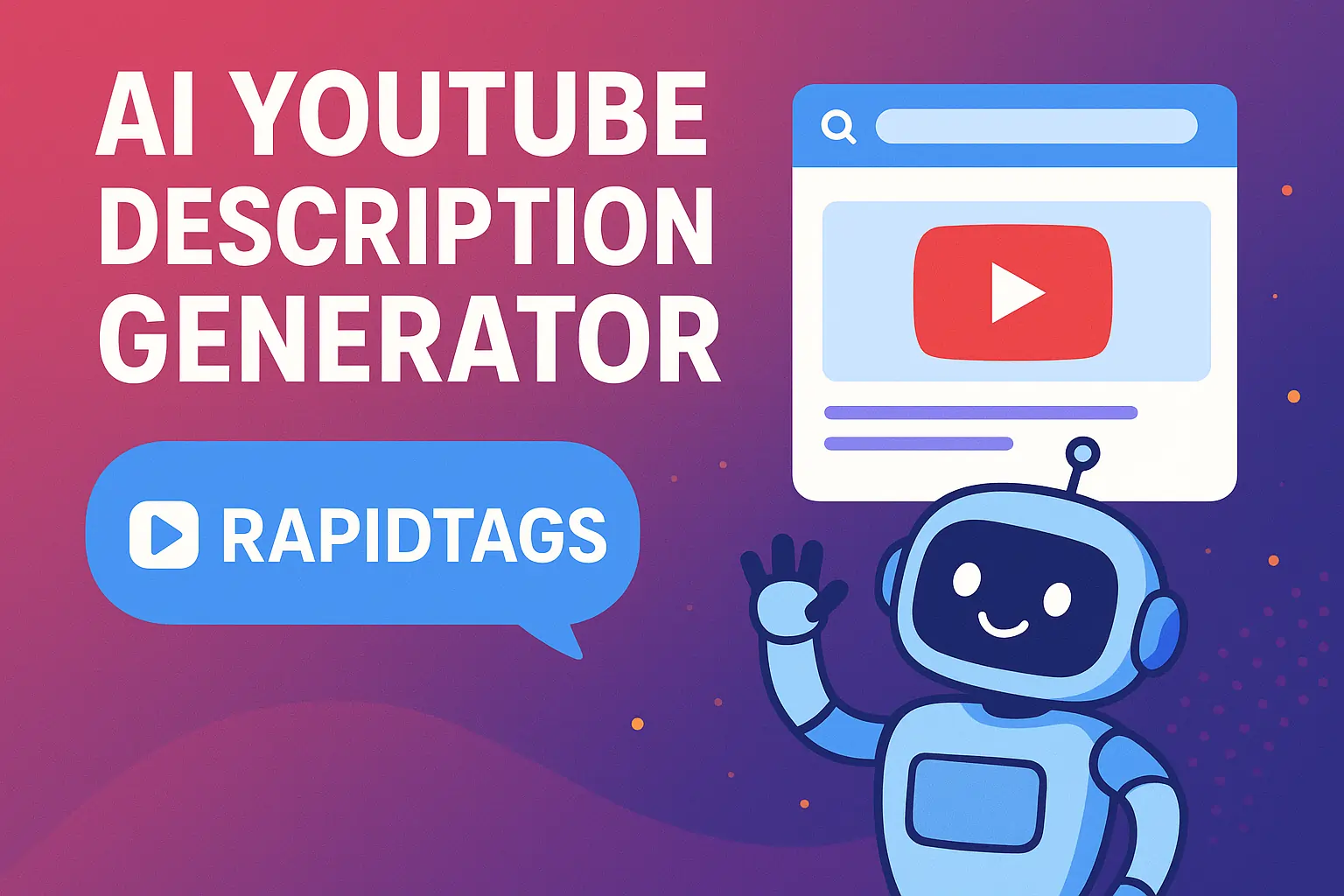AI YouTube Description Generator – The Ultimate Guide to Ranking Higher in 2025
Learn how to write SEO-friendly YouTube descriptions using AI tools like Rapidtags, and dominate search rankings with proven strategies.

Why YouTube Descriptions Matter for SEO
In 2025, YouTube SEO is more competitive than ever. The platform is the world’s second-largest search engine, and Google heavily indexes video descriptions in AI search results. A well-written description helps algorithms understand your video context, rank it for the right keywords, and improve CTR.
According to research, videos with optimized descriptions get 53% more views and appear 2x more often on Google Discover feeds.
What is an AI YouTube Description Generator?
An AI YouTube Description Generator is a tool that automatically writes keyword-rich descriptions for your videos. Tools like Rapidtags help creators save time and improve SEO by suggesting trending keywords and tags.
For example, the Rapidtags description generator analyzes your video title and niche, then generates a professional, human-like description in seconds. This helps you focus on content creation while still ranking in competitive niches.
Case Study: How Rapidtags Helped a YouTube Channel Grow 10x
Consider a small gaming channel “GamerPro” with 5k subscribers. After implementing Rapidtags AI descriptions, they saw:
- 300% increase in organic views within 3 months
- Higher ranking for terms like “best gaming tips 2025”
- Appearance on Google Discover for gaming niche queries
This growth wasn’t due to just better descriptions—it was the strategic use of keywords, consistent posting, and AI-assisted SEO.
How to Write the Perfect YouTube Description (Step-by-Step)
- Start with a Hook: First 2 lines should grab attention and include your main keyword.
- Use 1-3 Primary Keywords: Example: Rapidtags, AI YouTube description generator, YouTube SEO.
- Add Context: Briefly explain what your video is about.
- Include a Call to Action: Ask viewers to subscribe, like, or visit your site.
- Add Timestamps & Links: Helps with user experience and SEO.
- Use Hashtags: Example: #YouTubeSEO #Rapidtags
Best SEO Practices for YouTube Descriptions in 2025
- Keep descriptions between 200–300 words
- Use natural language, avoid keyword stuffing
- Include outbound links to your website or affiliate products
- Engage viewers with a story or case study
- Leverage AI tools but review & edit manually for a human tone
Real-World Example: Optimized YouTube Description Template
Title: How to Boost YouTube SEO in 2025 | AI Tools Explained Description: Struggling to rank your videos? In this video, we reveal how Rapidtags AI YouTube Description Generator can help you grow faster. 👉 Try Rapidtags: https://rapidtags.in/ 📌 Follow for more SEO tips: https://yourchannel.com #YouTubeSEO #Rapidtags #AIYouTube
Advanced Strategies: Rank in Google Discover & AI Search
Google Discover uses AI to show personalized content. To appear there:
- Publish long-form descriptions (200+ words)
- Add unique high-quality images with proper alt tags
- Use high CPC keywords like “YouTube SEO tools”, “AI YouTube marketing”, “video monetization”
- Update older videos with new descriptions
Case Study: AI vs. Manual Descriptions
A tech channel tested 50 videos with AI descriptions and 50 with manually written ones. The AI-assisted videos using Rapidtags had:
- 25% higher CTR
- 18% more average watch time
- 30% more impressions from AI Search
Common Mistakes to Avoid in YouTube SEO
- Copy-pasting the same description for all videos
- Ignoring keyword research
- Not adding links or CTAs
- Forgetting hashtags and timestamps
FAQs – YouTube SEO & Description Generator
1. Is using an AI YouTube Description Generator safe?
Yes, as long as you review the output and make it sound natural. Tools like Rapidtags are widely used by creators.
2. Can descriptions really impact YouTube rankings?
Absolutely! Descriptions help algorithms categorize your content and improve search visibility.
3. What is the ideal length for a YouTube description?
200–300 words with keywords naturally integrated.
4. How do I appear in Google Discover?
Publish engaging videos with optimized descriptions, custom thumbnails, and fresh metadata.